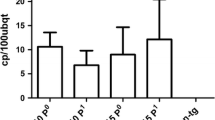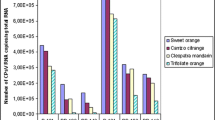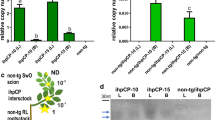Abstract
Citrus psorosis is a serious viral disease affecting citrus trees in many countries. Its causal agent is Citrus psorosis virus (CPsV), the type member of genus Ophiovirus. CPsV infects most important citrus varieties, including oranges, mandarins and grapefruits, as well as hybrids and citrus relatives used as rootstocks. Certification programs have not been sufficient to control the disease and no sources of natural resistance have been found. Pathogen-derived resistance (PDR) can provide an efficient alternative to control viral diseases in their hosts. For this purpose, we have produced 21 independent lines of sweet orange expressing the coat protein gene of CPsV and five of them were challenged with the homologous CPV 4 isolate. Two different viral loads were evaluated to challenge the transgenic plants, but so far, no resistance or tolerance has been found in any line after 1 year of observations. In contrast, after inoculation all lines showed characteristic symptoms of psorosis in the greenhouse. The transgenic lines expressed low and variable amounts of the cp gene and no correlation was found between copy number and transgene expression. One line contained three copies of the cp gene, expressed low amounts of the mRNA and no coat protein. The ORF was cytosine methylated suggesting a PTGS mechanism, although the transformant failed to protect against the viral load used. Possible causes for the failed protection against the CPsV are discussed.





Similar content being viewed by others
Abbreviations
- CPsV:
-
Citrus psorosis virus
- CP:
-
Coat protein
- TAS-ELISA:
-
Triple sandwich immunoassay
- PDR:
-
Pathogen-derived resistance
- CaMV:
-
Cauliflower mosaic virus
- AMV:
-
Alfalfa mosaic virus
- nos :
-
Nopaline synthase gene
- OD:
-
Optical density
- dpi:
-
Days post inoculation
- C-I:
-
Infected control
- C-NI:
-
Non-infected control
- PTGS:
-
Post-transcriptional gene silencing
- CTV:
-
Citrus tristeza virus
- GFLV:
-
Grapevine fan-leaf virus
- TSWV:
-
Tomato spotted wilt virus
References
Alioto D, Gangemi M, Deaglio S, Sposato S, Noris E, Luisoni E, Milne RG (1999) Improved detection of citrus psorosis virus using polyclonal and monoclonal antibodies. Plant Pathol 48:735–741. doi:10.1046/j.1365-3059.1999.00410.x
Barthe GA, Ceccardi TL, Manjunath KL, Derrick KS (1998) Citrus psorosis virus: nucleotide sequencing of the coat protein gene and detection by hybridisation and RT-PCR. J Gen Virol 79:1531–1537
Baulcombe DC (1996) Mechanisms of pathogen-derived resistance to viruses in transgenic plants. Plant Cell 8:1833–1844. doi:10.1105/tpc.8.10.1833
Beachy RN, Loesch-Fries S, Tumer NE (1990) Coat protein-mediated resistance against virus infection. Annu Rev Phytopathol 28:451–474
Bekesiova I, Nap J-P, Mlynarova L (1999) Isolation of high Quality DNA and RNA from leaves of the carnivorous plant Drosera rotundifolia. Plant Mol Biol Rep 17:269–277
Beñatena HN, Portillo MM (1984) Natural spread of psorosis in sweet orange seedlings. In: Garnsey SM, Timmer LW and Dodds JA (eds) Proceedings of the 9th conference of the international organization of citrus virologists, IOCV, Riverside, pp 159–164
Cervera M (2005) Histochemical and fluorometric assays for uidA (GUS) gene detection. Methods Mol Biol 286:203–214
Danós E (1990) La psorosis de los cítricos: la epidemia en curso en Argentina y el desafio de su control. In: International Foundation for Science (IFS) e Instituto Nacional de Tecnologia Agropecuaria (INTA) (eds) Revista de Investigaciones Agropecuarias, vol 22, pp 265–277
Domínguez A, Guerri J, Cambra M, Navarro L, Moreno P, Peña L (2000) Efficient production of citrus transgenic plants expressing the coat protein gene of Citrus Tristeza Virus. Plant Cell Rep. 19:427–433. doi:10.1007/s002990050751
Domínguez A, Hermoso de Mendoza A, Guerri J, Cambra M, Navarro L, Moreno P, Peña L (2002) Pathogen-derived resistance to Citrus tristeza virus (CTV) in transgenic Mexican lime (Citrus aurantifolia (Christ. ) Swing.) plants expressing its p25 coat protein gene. Mol Breed 10:1–10. doi:10.1023/A:1020347415333
Fagoaga C, López C, Hermoso de Mendoza A, Moreno P, Navarro L, Flores R, Peña L (2006) Post-transcriptional gene silencing of the p23 silencing supresor of Citrus tristeza virus confers resistance to the virus in transgenic Mexican lime. Plant Mol Biol 60:153-165. doi:10.1007/s11103-005-3129-7
Futterer J, Gisel A, Iglesias V, Kloti A, Kost B, Mittelsten Sceid O, Neuhaus-Url G, Schrott M, Shillito R, Spangenber G, Wang ZY (1995) Standard molecular techniques for analysis of trangenic plants. In: Potrykus I, Spangenberg G (eds) Gene tranfer to plants, Springer Lab manual, vol 25, pp 215
Gambino G, Gribaudo I, Stephan L, Scharti A, Laimer M (2005) Molecular characterization of grapevine plants transformed with GFLV resistance genes:I. Plant Cell Rep 24:665–662. doi:10.1007/s00299-005-0006-4
García ML, Dal Bo E, Grau O, Milne R (1994) The closely related citrus ringspot and citrus psorosis viruses have particles of novel filamentous morphology. J Gen Virol 75:3585–3590
Garnsey SM, Timmer LW (1980) Mechanical transmissibility of citrus ringspot virus isolates from Florida, Texas, and California. In: Calavan EC, Garnsey SM, Timmer LW (eds) Proceedings of the Eighth conference of the international organization of citrus virologists, IOCV, Riverside, pp 174–179
Garnsey SM, Youtsey CO, Bridges GD, Burnett HC (1976) A necrotic ringspot-like virus found in a “Star Ruby” grapefruit tree imported without authorization from Texas. In: Proceedings of the Florida State Horticultural Society, vol 89, pp 63–67
Ghorbel R, Lopez C, Fagoaga C, Moreno P, Navarro L, Flores R, Peña L (2001) Transgenic citrus plants expressing the citrus tristeza virus p23 protein exhibit viral-like symptoms. Mol Plant Pathol 2:27–36
Goldbach R, Bucher, Prins M (2003) Resistance mechanisms to plant viruses: an overview. Virus Res 92:207–212. doi:10.1016/S0168-1702(02)00353-2
Hily JH, Scorza R, Malinowski T, Zawadzka B, Ravelonandro M (2004) Stability of gene silencing-based resistance to Plum pox virus in transgenic plum (Prunus domestica L.) under field conditions. Transgenic Res 13:427–436. doi:10.1007/s11248-004-8702-3
Kalantidis K, Psaradakis S, Tabler M, Tsagris M (2002) The occurrence of CMV-specific short RNAs in transgenic tobacco expressing virus-derived double-stranded RNA is indicative of resistence to the virus. Mol Plant Microbe Interact 15:826–833
Kouassi NK, Chen L, Siré C, Bangratz-Reyser M, Beachy RN, Fauquet CM, Brugidou C (2006) Expression of rice yellow mottle virus coat protein enhances virus infection in transgenic plants. Arch Virol 151:2111–2122. doi:10.1007/s00705-006-0802-3
Levin JS, Thompson WF, Csinos AS, Stephenson MG, Weissinger AK (2005) Matrix attachment regions increase the efficiency and stability of RNA-mediated resistance to Tomato Spotted Wilt Virus in transgenic tobacco. Transgenic Res 14:193–206. doi:10.1007/s11248-004-5413-8
Maghuly F, Stephan L, da Câmara Machado A, Borroto Fernandez E, Mahmood AK, Gambino G, Gribaudo I, Schartl A, Laimer M (2006) Molecular characterization of grapevine plants transformed with GFLV esistance genes: II. Plant Cell Rep 25:546–553. doi:10.1007/s00299-005-0087-0
Milne RG, Garcia ML, Moreno P (2003) Citrus psorosis virus. Association of applied biologists (AAB) descriptions of plant viruses. http://www.dpvweb.net/dpv/showdpv.php?dpvno=401
Naum-Ongania G, Gago-Zachert S, Pena E, Grau O, Garcia ML (2003) Citrus psorosis virus RNA 1 is of negative polarity and potentially encodes in its complementary strand a 24 K protein of unknown function and 280 K putative RNA dependent RNA polymerase. Virus Res 96:49–61. doi:10.1016/S0168-1702(03)00172-2
Palle SR, Miao H, Seyran M, Louzada ES, da Graça JV, Skaria M (2004) Preliminary evidence for natural transmission of citrus psorosis virus by an olpidium-like fungus. In: 16th conference of the international organization of citrus virologists, IOCV, Abstract conference, Mexico
Pang SZ, Nagpala P, Wang M, Slightom JL, Gonsalves D (1992) Resistance to heterologous isolates of tomato spotted wilt virus in transgenic tobacco expressing its nucleocapsid protein gene. Phytopathology 82:1223–1229
Peña L, Cervera M, Juárez J, Navarro A, Pina JA, Durán-Vila N, Navarro L (1995) Agrobacterium-mediated transformation of sweet orange and regeneration of transgenic plant. Plant Cell Rep 14:616–619. doi:10.1007/BF00232724
Powell-Abel P, Nelson RS, De B, Hoffmann N, Rogers SG, Fraley RT, Beachy RN (1986) Delay of disease development in transgenic plants that express the tobacco mosaic virus coat protein gene. Science 232:738–743. doi:10.1126/science.3457472
Prins M de Haan P, Luyten R, van Veller M, van Grinsven MQ, Goldbach R (1995) Broad resistance to tospoviruses in transgenic tobacco plants expressing three tospoviral nucleoprotein gene sequences. Mol Plant Microbe Interact 8:85–91
Ravelonandro M, Scorza R, Bachelier JC, Labonne G, Levy L, Damsteegt V (1997) Resistance of Prunus domestica L. to plum pox virus infection. Plant Dis 81:1231–1235
Roistacher CN (1991) Graft-transmissible diseases of citrus. In: Food and Agriculture Organization of the United Nations, FAO (ed) Handbook for detection and diagnosis, Rome, pp 115–126
Roistacher CN (1993) Psorosis-A review. In: Moreno P, da Graça JV, Timmer LW (eds) Proceedings of the 12th conference of the international organization of citrus virologists, IOCV, Riverside, pp 139–154
Sánchez de la Torre ME, Riva O, Zandomeni R, Grau O, García ML (1998) Mol Plant Pathol. Online http://www.bspp.org.uk/mppol/1998/1019sanchez
Sánchez de la Torre ME, López C, Grau O, García ML (2002) RNA2 of citrus psorosis virus is of negative polarity and has a single open reading frame in its complementary strand. J Gen Virol 83:1777–1781
Sanford JC, Johnston SA (1985) The concept of parasite-derived resistance—deriving resistance genes from the parasite’s own genome. J Theor Biol 113:395–405
Scorza R, Callahan A, Levy L, Damsteegt V, Webb K, Revelonandro M (2001) Post-transcriptional gene silencing in plum pox virus resistant transgenic European plum containing the plum potyvirus coat protein gene. Transgenic Res 10:201–209. doi:10.1023/A:1016644823203
Swingle WT, Webber HJ (1896) The principal diseases of citrus fruits in Florida. United States Department of Agriculture, Division of Vegetable Physiology and Pathology, Bulletin 8
Vancanneyt G, Schmidt R, O´Connor-Sanchez L, Willmitzer L, Rocha-Sosa M (1990) Construction of an intron-containing marker gene: splicing of the intron in transgenic plants and its use in monitoring early events in Agrobacterium-mediated plant transformation. Mol Gen Genet 220:245–250
Zanek MC, Peña EJ, Reyes CA, Figueroa J, Stein B, Grau O, García ML (2006) Detection of Citrus psorosis virus in the northwestern citrus production area of Argentina by using an improved TAS-ELISA. J Virol Methods 137:245–251. doi:101016/jjviromet200606021
Acknowledgments
We thank Dr. L.W. Timmer for helpful discussion and manuscript revision, and Ing. G. Chiarrone and Pto. Agr. Fabián Ramos for greenhouse work. M. L. García, Eduardo J. Peña, Carina A. Reyes and M. C. Zanek belong to the staff of Facultad de Ciencias Exactas, UNLP, O.G. is recipient of the research career award from CICBA, and MLG from CONICET. Lic. Zanek and Reyes are fellows of CONICET. Lic. E.J. Peña is fellows of ANPCyT. This work was supported by grants from BID802 OC-AR PICT 6198 SECyT-CONICET, AECI, CICBA and INTA EEA Concordia.
Author information
Authors and Affiliations
Corresponding author
Additional information
Communicated by W. Harwood.
Rights and permissions
About this article
Cite this article
Zanek, M.C., Reyes, C.A., Cervera, M. et al. Genetic transformation of sweet orange with the coat protein gene of Citrus psorosis virus and evaluation of resistance against the virus. Plant Cell Rep 27, 57–66 (2008). https://doi.org/10.1007/s00299-007-0422-8
Received:
Revised:
Accepted:
Published:
Issue Date:
DOI: https://doi.org/10.1007/s00299-007-0422-8




